Feeding And Mulching: Experts Weigh In On Meeting Roses’ Nutritional Needs

PERENNIALS > ROSES > FEEDING

Elizabeth is a Permaculture Garden Designer, Sustainability Consultant and Professional Writer, working as an advocate for positive change. She graduated from the University of St. Andrews with an MA in English and Philosophy and obtained a Diploma in Applied Permaculture Design from the Permaculture Association.
Reviewed By COLIN SKELLY

Colin is a Horticulturist and Horticultural Consultant with experience in a range of practical and managerial roles across heritage, commercial and public horticulture. He holds the Royal Horticultural Society’s Master of Horticulture award and has a particular interest in horticultural ecology and naturalistic planting for habitat and climate resilience.
Contributions From STEWART POCOCK

Stewart established Pocock’s Roses plant nursery in 1985 and has been running it ever since. Also the founder of The Cornish Rose Company, another specialist seller, he has been an exhibitor at many RHS Flower Shows, including Hampton Court and Chelsea.

A Partner at Style Roses, Chris has worked in garden rose production for over 40 years and is the former Production & Marketing Manager for the Horticultural Department of Lincolnshire Field Products. Chris opened up his specialist nursery Style Roses in 1999 operating from Lincolnshire, specialising in standard and bush garden roses sold bare-root - and currently offers over 400 varieties of garden roses for sale.

Ben has been a professional gardener for over 20 years and is currently the nursery manager at Country Garden Roses. Country Garden Roses has been established for 35 years and is based at Black Birches in Shropshire, home to 500 different varieties of rose. The nursery has won several RHS medals, including Silver Gilt awards at the Shrewsbury Flower Show.

With over 45 years as a Co-Owner of Harkness Roses, Philip has made a name for himself in the rose industry. His plant nursery won gold medals at the Chelsea Flower Show in 2021 and have bred various new roses, including ‘The Duke of Edinburgh’ rose, which was handed to the Late HRH Queen Elizabeth II to commemorate what would have been her late husband’s 100th birthday.

David has over 40 years of experience growing and exhibiting fruit, flowers and vegetables, including for RHS Garden Harlow Carr. He is a qualified Judge and Lecturer for the RHS and is the current Vice Chairman of the RHS Fruit, Vegetable and Herb Committee. He’s also a Committee Member and Officer of a number of horticultural societies, including working as the Horticultural Advisor for the National Allotment Society.
IN THIS GUIDE
Roses are among the most popular flowers grown in the UK and consistently top charts of peoples’ favourite flowers.
Fortunately, these favourites come in a wide range of varieties to suit almost any garden and they are generally relatively easy to grow.
“The sheer amount of blooms and all the variations in fragrance, flower form and all the variations make me so passionate about growing roses,” says Stewart Pocock, a Partner at the specialist nursery Pocock’s Roses.
“They are a truly diverse genus of plants.”
Meeting roses’ nutritional needs and feeding roses what they need is one key concern for those who grow them.
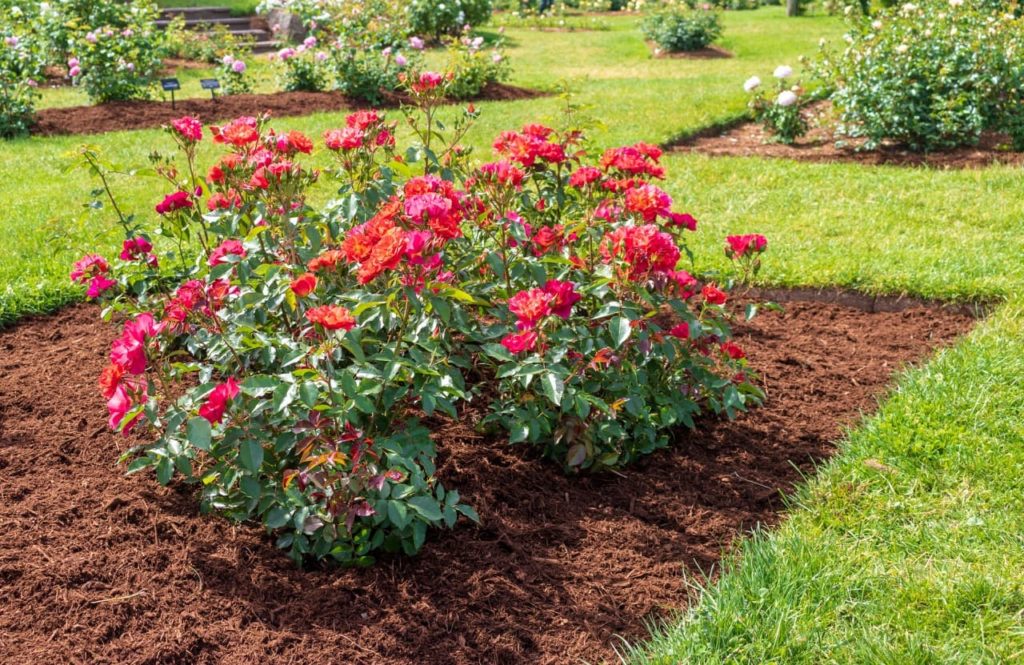
Feeding roses is something we’d typically consider before planting each year in the spring.
Here are some of the key pieces of information you need to know:
- Feed roses each year in March-April.
- Mulch after feeding with a rich organic matter.
- Choose organic options to avoid harm to the environment and wildlife.
- Container-grown roses need feeding more than those in the ground.
Read on for more information about keeping roses in top condition.
| Difficulty | Easy |
| Equipment Required | Fertiliser, mulch, watering can |
| When To Feed | Spring or throughout the flowering season |
When To Feed Roses
Roses are typically provided with a growing medium or soil that provides a good proportion of the nutrients that they need.
Choosing the right site to grow roses is, therefore, the number one thing that can be the difference between success and failure.
That said, roses are hungry plants, which do require a lot of nutrition to grow and flower well.

This means that they perform best when they are fed at least once a year and mulched well with organic matter after feeding.
Roses in the ground should usually be fed and mulched in March or April each year.
Those in containers will require more work and are typically provided with a liquid plant feed every second week from the middle of spring to late summer.
Why You Should Fertilise Roses
“The most important thing when caring for roses is to feed them at least twice a year to help keep them strong and healthy,” says Chris Styles, a partner at Style Roses.
“Regular fortnightly spraying during active growth before you see problems is recommended. You can alternate with natural bee-friendly products like Sulphur Rose, Uncle Tom’s Tonic and SB Plant Invigorator.
“These fertilisers will vastly improve the performance of your roses and eliminate most disease issues.”
Roses can often survive without any feeding at all when they are growing wild in a healthy soil.
Our own native rose varieties are extremely resilient and hardy and can cope with a wide range of soil conditions.
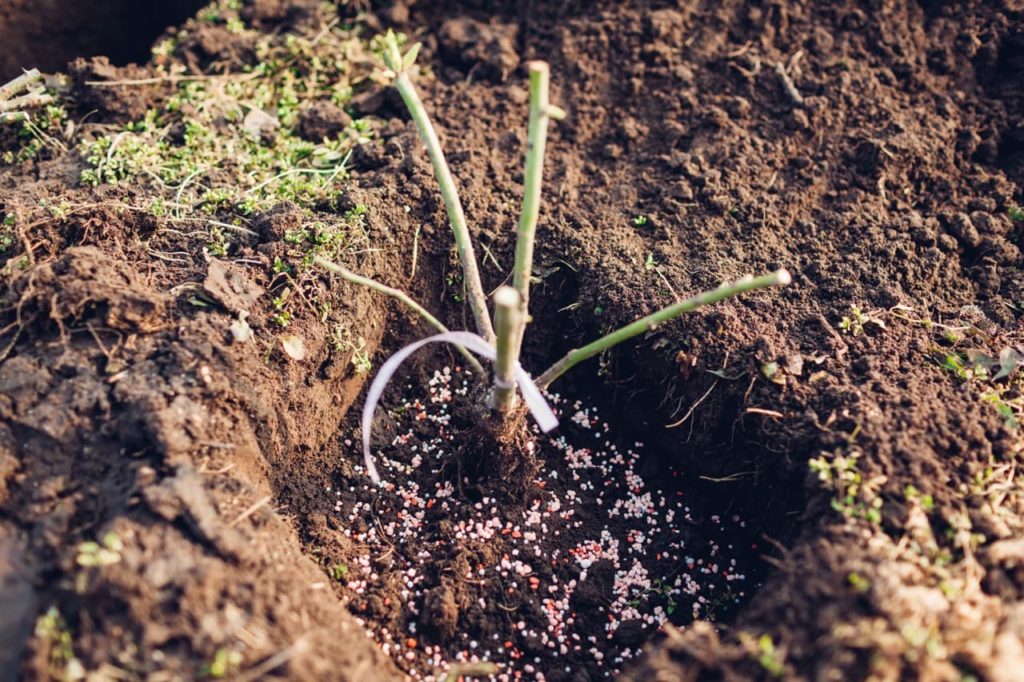
However, most of the roses grown in UK gardens are hybrid types or those that have been bred over generations to have the optimal visual appeal.
These plants are somewhat fussier than wild roses and are very hungry plants that often need additional feeding to perform at their best.
In many instances, where the soil is healthy and fertile, a good quality organic mulch can be sufficient to keep roses growing and blooming well.
“Alongside a good watering and feeding regime, a good mulch also provides a barrier from pests and diseases,” says Ben Stirton, the nursery manager at Country Garden Roses.
However, where the soil may be lacking in nutrients or where the growing conditions are not ideal, feeding is often essential to get the right results.
The Importance Of Choosing Organic Options
Unfortunately, for many gardeners, the usual response when growing roses is to reach for non-organic, synthetic fertilisers.
These can sadly often do more harm than good and are a poor choice for wildlife and the environment.

What’s more, roses themselves may suffer or fail to thrive due to over-feeding with synthetic fertilisers.
Whenever you are seeking sustainable and eco-friendly options for feeding roses, it is important to restrict yourself to organic options.
Healthy Soil Equals Happy Roses
The key thing to remember about feeding roses is that roses take their nutrition from the soil or growing medium in which they grow and they need a good quality and fertile soil or growing medium to thrive.
One interesting thing that goes on below the soil around roses is that roses form a symbiosis with mycorrhizae, which form fungal networks stretching out from the roots of the roses into the surrounding soil.1Mycorrhizal Fungi. (n.d.). David Austin Roses. Retrieved March 20, 2023, from https://www.davidaustinroses.co.uk/products/david-austin-mycorrhizal-fungi
This type of connection occurs with many plants and it significantly increases the amount of soil the plants can access for nutrients and water, expanding their root system.2Mahr, S. (n.d.-e). Mycorrhizae. Wisconsin Horticulture. Retrieved March 20, 2023, from https://hort.extension.wisc.edu/articles/mycorrhizae/
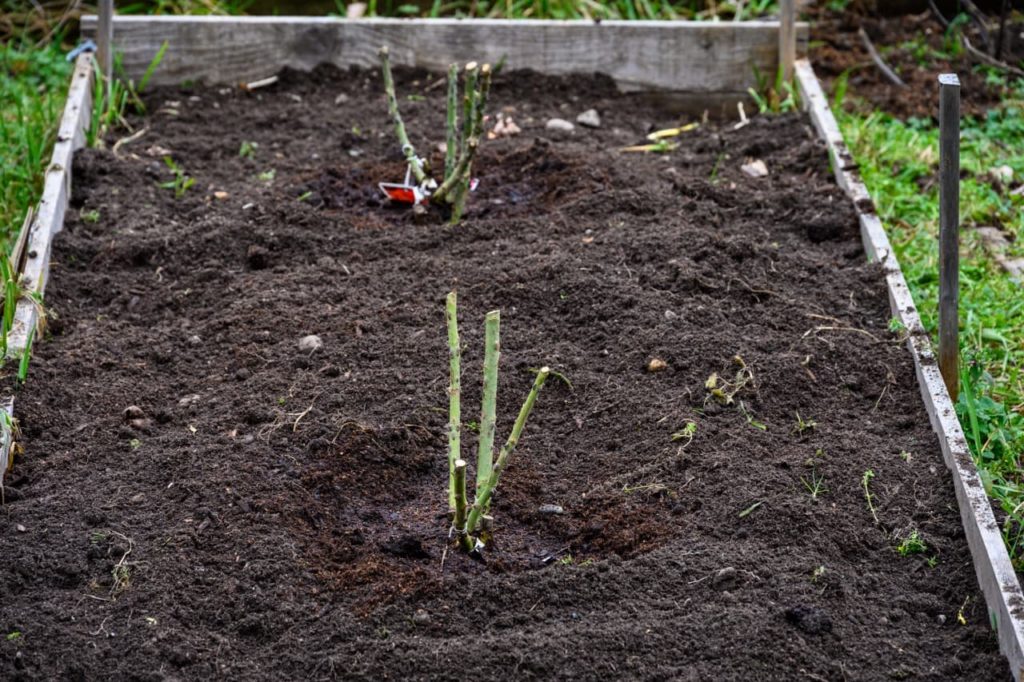
Often, ensuring healthy soil means building healthy fungal networks that aid roses and other plants meaning that less intervention from us is required.
When feeding roses, the first step is always to ensure that you have healthy soil that is rich in organic matter and supports and sustains a wide variety of life, including the microbial life that helps roses and other plants to thrive.
“Using mycorrhizal fungi granules at planting time on all roses makes a huge difference to the establishment and the performance of roses,” says Chris.
We can maintain healthy soil by disturbing it as little as possible, protecting it with living roots, ground cover and mulches, and, of course, by gardening organically at all times.
Feeding Roses Growing In The Ground
When roses are growing in the soil, they can tap into the resources present in the soil in which they grow since, thanks to mycorrhizae, they can draw on nutrients even beyond their own root systems.
This means that they can often be content with much less feeding than roses that are grown in containers, confined beds or planters.
However, as mentioned above, especially where the soil may leave something to be desired, feeding can definitely be important in order to achieve the right results.
Often, feeding roses more than once a year is recommended, but if your soil is healthy, it is generally only necessary to feed once a year in the spring by sprinkling organic fertiliser around the base of the plants.
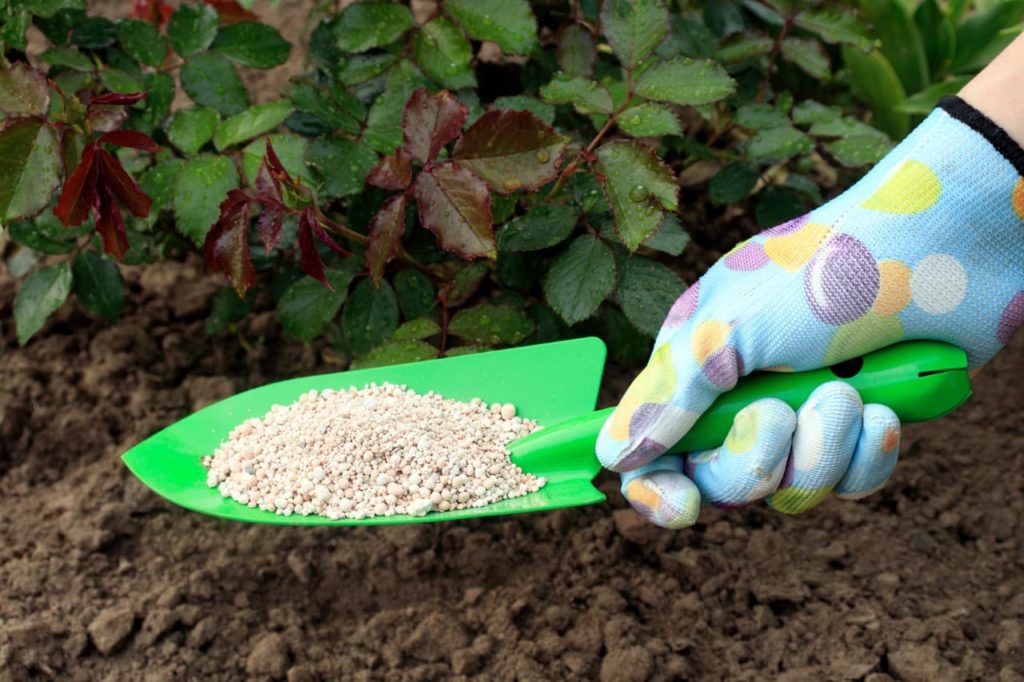
“Feed in spring with a slow-release fertiliser, such as osmocote,” Stewart suggests.
It can be helpful to understand which nutrients might be lacking in your soil in order to understand which organic fertiliser you might add and you can often use things from your home to make your own feeds rather than buying anything.
“I feed my roses annually with a granular feed like national growmore, tonk’s rose feed or fish blood and bone,” shares David Allison from the NSALG.
“I then add a high potash liquid feed during the season to encourage good strong colours in the blooms.”
To name a few examples, you might add:
- Egg shells for calcium.
- Banana peels for potassium and magnesium.
- Fish bones for a number of micro-nutrients and phosphorus.
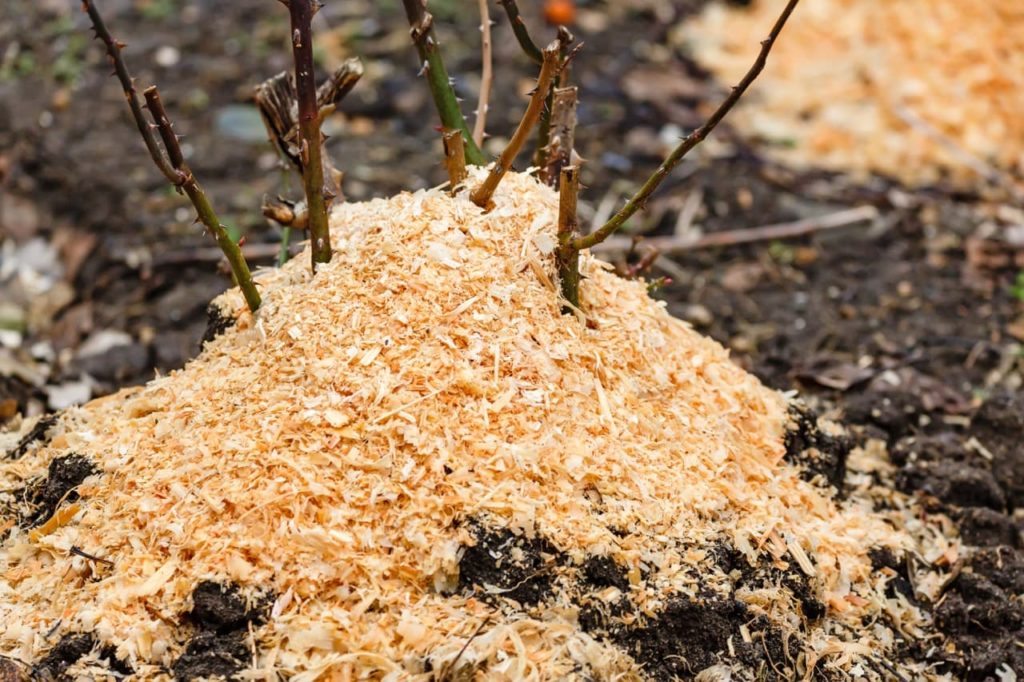
These and other organic additions can be added to a planting hole when planting new roses or crushed, chopped and spread around the roses in spring before you mulch around the area with your primary slow-release feed and mulch material.
“From late May onwards, feed weekly with either a liquid rose fertiliser or a liquid tomato fertiliser,” adds Stewart.
“We use Uncle Tom’s rose tonic regularly and this helps immensely with flower production.”
Feeding Roses Growing In Containers
“Roses have a big appetite and if you satisfy the need for food and water, you will get more flowers,” Philip from Harkness Roses says.
Roses growing in containers, as mentioned above, need more feeding than those growing in the soil because they do not have the wonderful web within the soil to fall back on.
Therefore, they will be more dependent on us, as gardeners, to meet their needs.
“Use good quality compost and add a slow-release fertiliser in spring,” says Philip.

“During the growing season, use a liquid feed once every two weeks or so.”
The fortnightly feed for roses before buds form should be a general-purpose, relatively balanced organic liquid fertiliser, such as compost tea.
You can make your own compost tea as long as you make your own compost at home.
Once the flower buds form, it is then best to switch to a potassium-rich organic liquid plant feed.
This is also something that you can make yourself at home, using any potassium-rich leaves from plants like comfrey or other dynamic accumulators of potassium.
Mulching Roses
Mulching roses is, for me at least, the most important stage when it comes to caring for roses and making sure that they have the nutrition they need throughout the year.
I always mulch roses with good quality homemade compost or manure after any other fertilisers are added in the spring.
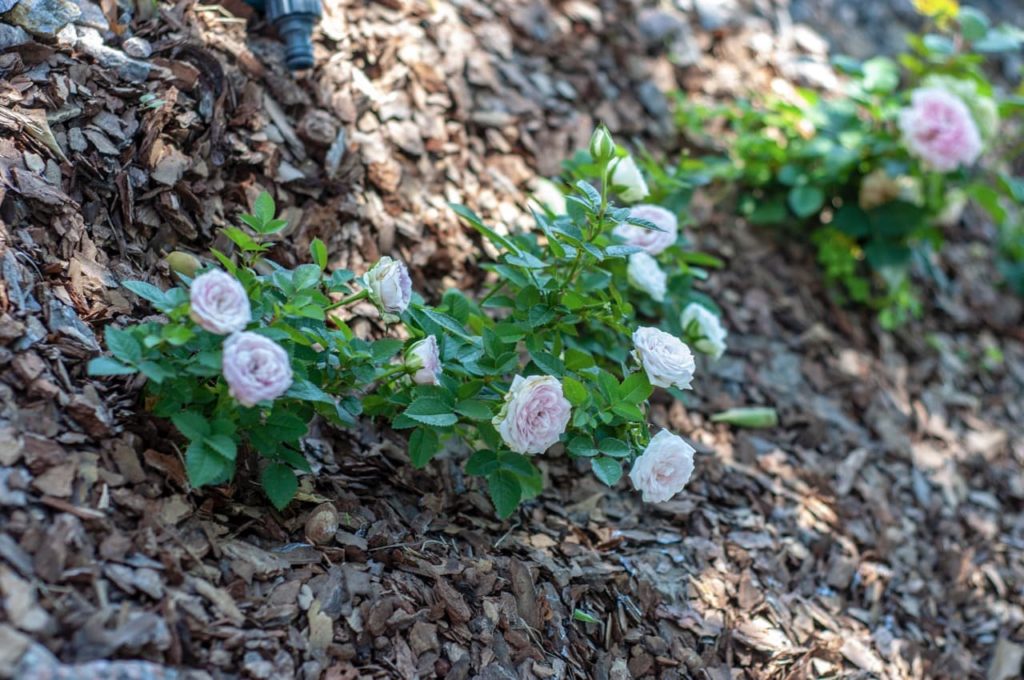
I replenish this mulch each spring, on the surface of the soil or on top of the growing medium in containers.
“A good pruning regime and an annual mulch of organic matter which will do three things,” says David Allison.
“It will provide nutrients to the roots as it decomposes, act as a weed suppressant and help to retain moisture in the soil.”
The mulch not only protects the soil and provides slow-release fertility throughout the summer as the mulch breaks down, but it also helps to suppress weed growth, thereby ensuring that roses do not have as much competition to contend with and are able to grow strong.
References
- 1Mycorrhizal Fungi. (n.d.). David Austin Roses. Retrieved March 20, 2023, from https://www.davidaustinroses.co.uk/products/david-austin-mycorrhizal-fungi
- 2Mahr, S. (n.d.-e). Mycorrhizae. Wisconsin Horticulture. Retrieved March 20, 2023, from https://hort.extension.wisc.edu/articles/mycorrhizae/
